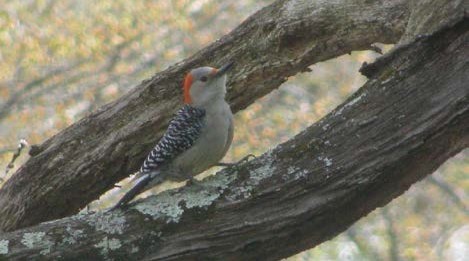David M. Larson

Red-Bellied Woodpecker (Photograph by Peter Oehlkers)
Bergmann’s Rule indicates that, for birds and mammals, individuals in colder climes will be larger in body size and mass than those in warmer climes (Bergmann 1847). Although Bergmann described the relationship of species within a genus, this rule has been shown to be mostly valid for populations within species as well. Hence, resident Bald Eagles and white-tailed deer in Florida are considerably smaller than those in Massachusetts, and similar size gradients have been demonstrated in other widespread species, including Song Sparrows, Downy and Hairy woodpeckers, and many others. The classical explanation for Bergmann’s Rule is based on surface-to- volume ratio. For a given body shape, as linear dimensions increase, volume increases faster than surface area. Larger individuals, with relatively more volume to create heat, should have a selective advantage in colder climates because heat generation is a function of volume, whereas heat loss is a function of surface area.
So, what happens to Bergmann’s Rule during range expansion of a species?
Kirchman and Schneider (2014) studied the recent range expansion in Red- bellied Woodpeckers (Melanerpes carolinus), which many Massachusetts birders have observed during their lifetimes. Red-bellied Woodpeckers are quite sensitive to cold, and their range is limited by average minimum winter temperature, even when supplemental feeding is available. The authors used a combination of distribution and morphometric data from 22 North American museum collections and sighting data from National Audubon’s compilation of North American Christmas Bird Counts (CBC; from 1900 to present) and from the United States Geological Survey’s Breeding Bird Survey (BBS; 1966 to present). The CBC and BBS data provided information on range of this species in the winter and summer (respectively), but the distribution data from museum specimens was not seasonally restricted.
Range Expansion
Mapping the distribution of this species over the decades clearly demonstrates that the woodpeckers expanded their range to the north and west starting in the 1950s. All three databases show this trend. The average expansion from the 1970s to 2000s was 0.82 degrees of latitude per decade for CBC data and 0.52 for BBS data. Westward range expansion was roughly half the magnitude (in degrees) of the northward expansion in these analyses. Comparing CBC and BBS data indicates that winter records increase northward before summer records. Although Red-bellied Woodpeckers are largely resident birds, younger birds—usually males—often venture far from their natal territories during the autumn and winter. New areas occupied by wintering birds often become part of the breeding range within one to two decades.
Body Size
The authors made direct measurements on museum study skins from 406 adults. They used wing chord measurement as a body-size proxy, separating males from females (males are larger). In the pre-range-expansion period (1867-1949), there was a positive correlation between body size and degrees north latitude for both males and females. Such a relationship, with increasing body size to the north, is fully consistent with Bergmann’s Rule. However, when the authors examined body size from 1950 on, during the period of rapid expansion and rapid climate change, this correlation broke down. In order to more finely tune the analyses, the authors examined specimens from the northern periphery of the species’ range. Birds collected near the old northern boundary (41-44oN in 1869-1939) were larger than those collected from the same latitudes recently (1989-2009), significantly so for females. In addition, males collected (1970-2009) near the current northern boundary (north of 44.5oN) were smaller than birds collected earlier near the pre-expansion northern boundary. These boundary analyses reinforce the notion that rapid range expansion in this species has allowed it to escape from Bergmann’s Rule.
One suggestion from this project is that establishment of the size gradients consistent with Bergmann’s Rule require relatively static populations with low gene flow. Such a stable situation would allow for population level adaptation to local climatic conditions, assuming that body size has a significant genetic basis. Under conditions of increased mean winter temperatures, selection pressure eases and Red- bellied Woodpeckers could survive in more northerly latitudes. The movement of individuals and expansion of population range could disrupt the stability presumably required for maintaining Bergmann’s Rule.
One important caveat to this study is the low number of recent specimens in museum collections, which limits the utility of the body size analyses in the past few decades. While the authors suggest further collection efforts might help fine-tune the work, widespread collecting of native birds seems unlikely in the present. As an alternative, the researchers could include data from bird banding stations throughout eastern North America in their analyses. Wing chord, weight, and a variety of other morphometric measurements are made routinely on mist-netted birds, and some banding stations have many decades of data. While acquiring these data might be somewhat arduous, their inclusion could greatly increase the number of more contemporary specimens in this analysis.
Red-bellied Woodpeckers and some other members of the Carolinian avifauna, e.g., Northern Cardinal, Carolina Wren, and Tufted Titmouse are often cited as examples of the northward range shift in response to climate warming. All of these relatively recent additions to the avifauna of New England provide interesting models for the dynamics of range expansion and the consequences for these birds in a changing world.
References
- Bergmann, C. 1847. Über die Verhältnisse der Wärmeökonomie der Thiere zu ihrer Größe. Göttinger Studien 3(1): 595-708.
- Kirchman, J.J. and K.J. Schneider. 2014. Range Expansion and the Breakdown of Bergmann’s Rule in Red-bellied Woodpeckers (Melanerpes carolinus). Wilson Journal of Ornithology 126(2): 236-48.
David M. Larson, PhD, is the Science and Education Coordinator at Mass Audubon’s Joppa Flats Education Center in Newburyport, the Director of Mass Audubon’s Birder’s Certificate Program and the Certificate Program in Bird Ecology (a course for naturalist guides in Belize), a domestic and international tour leader, Vice President of the Nuttall Ornithological Club, and a member of the editorial staff of Bird Observer.